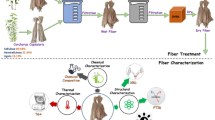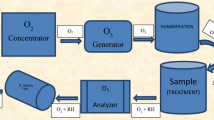Abstract
Jute is a lignocellulosic fiber, having three principal chemical constituents: alpha-cellulose, hemicellulose and lignin, while jute stick leftover after fiber extraction is also lingocellulosic. This chapter deals with the brief composition of lignin, cellulose, hemicelluloses and other minor components together with linkages of lignin with other components. Locations of major jute constituents as well as chemical composition of jute fiber at different stages of plant growth are discussed. The effects of common chemicals and light on jute as well as methods for estimation of major jute constituents have been described. Some important chemical processes such as bleaching, dyeing, woollenization for the production of high-value jute diversified products are briefly reported. Several useful products, developed by utilizing jute chemistry, have been mentioned, viz. pulp and paper, activated charcoal, furfural, oxalic acid, microcrystalline cellulose, carboxymethyl cellulose, and nanocellulose. In the end, major environmental impacts of natural jute fiber vis-à-vis synthetic fiber have also been mentioned.
Access this chapter
Tax calculation will be finalised at checkout
Purchases are for personal use only
Similar content being viewed by others
References
Abdullah ABM (2010) Jute Products. Jute Basics, International Jute Study Group, Dhaka, Chapter 6:120–131
Abraham E, Deepa B, Pothan LA, Jacob M, Thomas S, Cvelbar U, Anandjiwala R (2011) Extraction of nanocellulose fibrils from lignocellulosic fibres: a novel approach. Carb Poly 86:1468–1475
Alam MM, Rahman ML, Haque MZ (2007) Extraction of henna leaf dye and its dyeing effect on textile fibre. Bang J Sci Ind Res 42(2):217–222
Asadullah Md, Asaduzzaman Md, Kabir Md S, Mostofa Md G, Miyazawa T (2010) Chemical and structural evaluation of activated carbon prepared from jute sticks for brilliant green dye removal from aqueous solution. J Hazard Mat 174:437–443
Aspinall GO, Dasgupta PC (1958) The constitution of jute hemicelluloses. J Indian Chem Soc 724:3627–3631
Aziz MdA, Chowdhury IR, Mazumder Md AJ, Chowdhury S (2019) Highly porous carboxylated activated carbon from jute stick for removal of Pb2+ from aqueous solution. Environ Sci Pollut Res 26:22656–22669
Baheti VK, Abbasi R, Militky J (2012) Ball milling of jute fibre wastes to prepare nanocellulose. World J Engg 9(1):45–50
Barker SG (1939) Science of Jute. J Text Inst 30:272–304
Bell WA (1969) Bulletin No. 12, British Jute Trade Res Assoc, p 154
Bhatacherjee HP, Macmillan WG (1958) The influence of lignin on the photochemical degradation of cellulose in jute fibre. Sci Cult 24:36–38
Bhattacherjee HP, Dutt AS, Macmillan WG (1965) Effect of mineral batching oil on the yellowing of jute on exposure to light. Indian J Techol 3(2):63–65
Callow HJ, Speakman JB (1949) The action of light on jute. J Soc Dyer Col 65:174–179
Chakravarty AC (1962) Crimp produced in jute fibres by treatment with solutions of sodium hydroxide. Tex Res J 32(6):525–526
Chatterjee H (1950) The role of the cationic ash of jute fibre in its acid value determination. J Text Inst 41:T243-245
Chatterjee H, Pal KB, Sarkar PB (1954) Molecular weight of α-cellulose from jute and allied long fibers. Text Res J 24:43–52
Chatterjee H, Pal KB (1955) Bleaching jute with hydrogen peroxide. J Soc Dyer Col 71(9):525–530
Chatterjee H (1959) Chemical characters of jute fibre at different stages of plant growth. J Sci Ind Res 18C:206–211
Chattopadhyay DP, Sharma JK, Chavan RB (1999) Sequential bleaching of jute with eco-friendly peracetic acid and hydrogen peroxide. Indian J Fib Text Res 24:120–125
Chattopadhyay SN, Pan NC, Day A (2002) Ambient temperature bleaching and reactive dyeing of jute: the effects of pretreatment, bleaching and dyeing methods. J Text Inst 93:306–315
Chattopadhyay SN, Pan NC, Roy AK, Saxena S, Khan A (2013) Development of natural dyed jute fabric with improved colour yield and uv protection characteristics. J Text Inst 104(8):808–818
Chattopadhyay SN, Pan NC (2018) Ecofriendly printing of jute fabric with natural dyes and thickener. J Nat Fib 16(8):1–12
Chattopadhyay SN, Pan NC, Khan A (2018) Printing of jute fabric with natural dyes extracted from manjistha, annatto and ratanjot. Indian J Fib Text Res 43:352–356
Chavan RB (1999) Chemical processing of handloom yarns and fabric. Dept of Text Techol, Indian Inst of Techol, New Delhi, p 6
Chen W, He F, Zhang S, Xv H, Xv Z (2018) Development of porosity and surface chemistry of textile waste jute-based activated carbon by physical activation. Environ Sci Poll Res (published online: 25 Jan 2018; https://doi.org/10.1007/s11356-018-1335-5)
Das NN, Das SC, Dutt AS, Roy A (1981) Lignin-xylan ester linkage in jute fibre (Corchorus capsularis). Carb Res 94:73–82
Dasgupta PC, Sarkar PB (1954) Nature of the hemicellulose of jute fibre. Pt.2. Text Res J 24:705–711
Datta AS (1960) A Study on the Physical and Chemical Characteristics of Jute Fibre at Different Growth Stage of the Plant and on the Mode of Association of the Compounds of the Mature Fibre. PhD Thesis, University of Calcutta
Doree C (1947) The Methods of Cellulose Chemistry. Chapman & Hall, London, UK, p 16
Ghosh P, Samanta AK, Basu G (2004) Effect of selective chemical treatment on jute fibres aimed at improved textile related properties and processibility. Indian J Fib Text Res 29:85–99
Guha AK (1981) Carboxymethyl cellulose from jute stick. J Tex Assoc. 42:151–152
Guha Roy TK, Chatterjee S, Adhikari D, Mukherjee AK (1988) Studies on the bleaching of jute. J Text Inst 79(1):108–125
Guha Roy TK, Chatterjee SK, Das Gupta B, Mukherjee AK (1993) Improvement of Physico-Chemical Properties of Jute / Kenaf Fibre, Yarn, Fabric for the Production of Value Added and Diversified Products -- Dyeing of Jute/Kenaf, IJO/CFC Project (IJO/Ind/07): Third Interim Report
Guha Roy TK (1996) Woollenising jute to improve quality. Indian Text. J 106(12):102–103
Guha Roy TK, Chatterjee SK, Dasgupta BD (2002) Comparative studies on bleaching and dyeing of jute after processing with mineral oil in water emulsion vis-a-vis self-emulsifiable castor oil. Colourage 49(8):27–33
Guha Roy TK (2010) Eco-Status of Jute. Jute Basics, International Jute Study Group, Dhaka, Chapter 7:133–145
Gulrajani ML, Gupta D (1992) Natural Dye and their Application to Textiles, Dept. of Textile Technology, Indian Institute of Technology, New Delhi, pp 20–35
Ingaki H (2000) Progress on Kenaf in Japan. American Kenaf Society, USA, Third Annual Conf
Jahan MS, Saeed A, He Z, Ni Y (2011) Jute as raw material for the preparation of microcrystalline cellulose. Cellulose 18:451–459
Kasyapi N, Chaudhary V, Bhowmick AK (2013) Bionanowhiskers from jute: preparation and characterization. Carb Poly 92:1116–1123
Lewin M, Shiloh M, Banbaji J (1959) The crimp of alkali treated jute fibers. Text Res J 29:373–385
Liu A (2000) Jute–An environmentally friendly product. International Commodity Organisation in Transition, UN Conf on Trade and Dev
Macmillan WG, Basu SN (1947) The detection and estimation of damage in jute fibres - Part I. a new microscopical test and the implications of certain chemical tests. J Text Inst 38:T350-370
Macmillan WG, Sengupta AB, Majumdar SK (1949) Studies in the bleaching of jute - Part I - The action of sodium hypochlorite. J Indian Chem. Soc, Indus & News Ed. 12:105–112
Macmillan WG, Sengupta AB, Majumdar SK (1950) Studies in the bleaching of jute - Part II - Action of common bleaching agents. J Indian Chem. Soc. Indus & News Ed. 13:115–128
Macmillan WG, Sengupta AB, Ray A (1952) Observations on the determination of lignin in jute. J Text Inst 43(2):P103-111
Macmillan WG, Sengupta AB, Majumdar SK (1954) A study of the action of alkalis on jute. J Text Inst 45:T703-715
Macmillan WG, Dutt AS, Sengupta AB (1955) Observations on the chemical composition of jute at different stages of plant growth. Sci Cult 20:566–568
Macmillan WG, Sengupta AB, Dutt AS (1956) Chromatographic study of jute alpha –cellulose. Nature 178:1346–1347
Majumdar P, Sanyal S, Das Gupta B, Shaw SC, Guha Roy TK (1994) Bleaching of jute with peracetic acid. Indian J Fib Text Res 19(4):286–292
Majumdar SK (1956) Action of Some Common Bleaching Agents and Alkalis on Jute. PhD Thesis, University of Calcutta
Majumder A, Samajpati S, Ganguly PK, Sardar D, Dasgupta PC (1980) Swelling of jute: heterogineity of crimp formation. Text Res J 50(9):575–578
Mathew MD, Gopal M, Banerjee SK (1984) Preparation of oxalic acid from jute stick, an
agrowaste. Agri Waste 11:47–59
Mathew MD, Gopal M, Day A, Banerjee SK (1984) Production of furfural from jute stick. Indian Pulp Paper 39(3):17–18
Megregor EA, Greenwood CT (1982) Polymers in Nature. John Wiley, Chichester, UK Chapter 7
Mukherjee A, Ganguly PK, Sur D (1993) Structural mechanics of jute: the effects of hemicellulose or lignin removal. J Text Inst 84:348–353
Mukhopadhyay U (1976) Effect of different wavelengths in the solar spectrum on discolouration of jute. Text Res J 46(2):153–154
Navell TP, Zeronian SH (1985) Cellulose Chemistry and its Applications. Ellis Harwood Ltd., Chichester, UK
Ott E, Spurlin MM, Grafflin MW (1954) Cellulose and Cellulose Derivatives. Interscience 93:461
Pan NC, Chattopadhyay SN, Day A (2003) Dyeing of jute natural dyes. Indian J Fib Text Res 28:339–342
Pan NC, Chattopadhyay SN, Roy AK, Patra A (2007) Pigment printing of jute fabric. J Inst Engg (India). Textile Engg 38:56–57
Pandey SN, Anantha Krishnan SR (1990), Fifty Years of Research 1939–1989. Jute Technol Res Lab, Calcutta, pp 46, 49
Parsons HL (1939) Chemistry in the processing of jute. J Text Inst 30(9):P311-317
Patro PS (1971) Dyeing of jute with basic, acid, direct and sulphur dyestuffs. Text Dyer Print 4(8):57–62
Phan NH, Rio S, Faur C, Le Coq L, Le Choirec P, Nguyen TH (2006) Production of fibrous activated carbons from natural cellulose (Jute, Coconut) fibers for water treatment application. Carbon 44(12):2569–2577
Ray A (1968) Chemistry of jute (Part II). Jute Chronicle 3(6):134–138
Ridge BP, Little AH, Wharton J (1944) Jute cellulose and the relation of jute incrustants to fibre and yarn strength. J Text Inst 35:T93-116
Saha PK, Das Gupta PC, Mukherjee PP (1973) Annual Report. Jute Technol Res Lab, Calcutta, p 17
Samanta AK, Agarwal P (2008) Application of mixtures of red sandal wood and other natural dyes for dyeing jute fabric–studies on dye compatibility. Int Dyers 193(2):37–42
Samanta AK, Guha Roy TK (2010) Chemical Processing of Jute. Jute Basics, International Jute Study Group, Dhaka, Chapter 5:98–102
Sarkar PB (1931) Chemistry of jute lignin Pt.1. comparative study of different methods of isolation. J Indian Chem Soc 8:397–405
Sarkar PB (1933) Chemistry of jute lignin Pt.2. potash fusion of lignin. J Indian Chem Soc 10:263–270
Sarkar PB, Chatterjee H, Majumdar AK (1946) Absorption of basic dyes by jute. Nature 157:486
Sarkar PB, Chatterjee H, Mazumdar AK (1947) Acid nature of jute fibre. J Text Inst 38(9):T318-332
Sarkar PB, Chatterjee H (1948) Studies on the absorption of methylene blue by the fibre. J Soc Dyer Color 64:213–221
Sarkar PB, Mazumdar AK, Pal KB (1948) The hemicelluloses of jute fibre. J Text Inst 39(2):T44-58
Sengupta AB, Callow HJ (1951) Progressive delignification of jute fibre with chlorine dioxide. J Text Inst 42:T375-384
Sengupta AB, Dutt AS (1958) Isolation and Mode of Association of Jute Alpha Cellulose with Other Sugar Residues. Cellulose Research–a Symposium, Council of Scientific and Industrial Research, India, pp 142–149
Sengupta AB, Majumdar SK, Macmillan WG (1958) Isolation of jute holocellulose by the action of sodium chlorite. Indian J Appl Chem 21:105–110
Sengupta AB, Radhakrishnan T (1972) New Ways to Produce Textiles, Proc. 57th Annual Conference of Text Inst, pp 112–124
Sur D, Amin MdN (2010) Physics and Chemistry of Jute. Jute Basics, International Jute Study Group, Dhaka, Chapter 3:35–55
TAPPI Test Methods (1991) Vol.1 T222-OM-88, Technical Association of the Pulp and Paper Industries, Atlanta, New York, USA
Author information
Authors and Affiliations
Editor information
Editors and Affiliations
Rights and permissions
Copyright information
© 2022 The Author(s), under exclusive license to Springer Nature Switzerland AG
About this chapter
Cite this chapter
Roy, T.K.G., Sur, D., Nag, D. (2022). Chemistry of Jute and Its Applications. In: Zhang, L., Khan, H., Kole, C. (eds) The Jute Genome. Compendium of Plant Genomes. Springer, Cham. https://doi.org/10.1007/978-3-030-91163-8_3
Download citation
DOI: https://doi.org/10.1007/978-3-030-91163-8_3
Published:
Publisher Name: Springer, Cham
Print ISBN: 978-3-030-91162-1
Online ISBN: 978-3-030-91163-8
eBook Packages: Biomedical and Life SciencesBiomedical and Life Sciences (R0)




